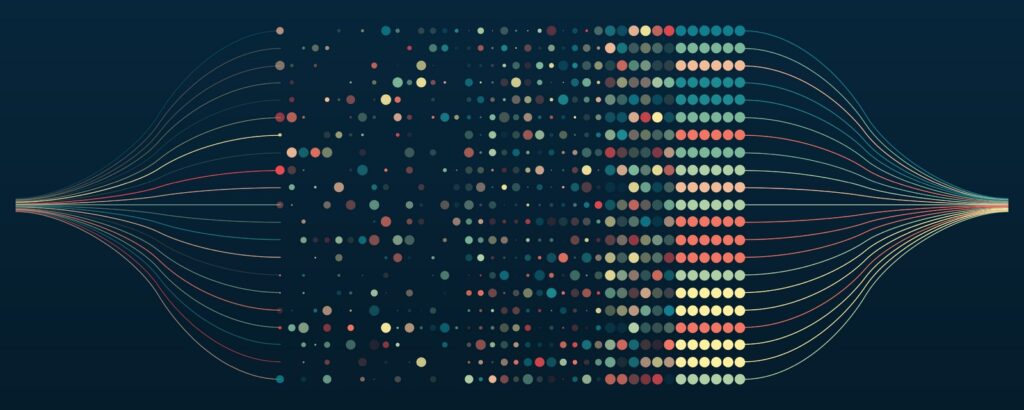Real-Time Analytics for Automated Response
What Modern Data Processing Looks Like
Last century, we could put a dashboard on a monitor, and auto-refresh it every 60 seconds, so that a human could stare at it and make a phone call when something didn’t look right.
Today, we like to put bots in front of virtual dashboards that refresh thousands of times per second and trigger automated responses when the bot sees something. Cheaper, Better, and Faster!

RioDB is a super easy way to set up powerful data screening bots!
How is RioDB setup?
The RioDB API accepts SQL-like statements, which can:
Create a Stream, such as subscribing to a remote Kafka topic or opening a UDP listener on the RioDB instance.
Define how the ingested data should be parsed into fields.
Form Windows that hold computed statistics and refresh continuously, after each record is received.
Finally, deploy queries that run indefinitely (after each record is received) and take automated actions.
What will RioDB do?
As RioDB receives data from your data source, it will parse each record received and will execute all queries, one record at a time. For example, if the stream supplies 135k records per second, RioDB will re-execute all your queries 135k times per second!
Each query is configured with an automated action to be triggered when the query conditions are met.
Once a condition is met, and the automated action is triggered, the query can be silenced for some time to avoid triggering the same action millions of times.
Use Cases for Real-Time Data Processing
The ideal use case for RioDB is to monitor a stream of data, triggering automatic actions when the data presents something of interest.
A typical architecture for this is to deploy RioDB as a “side-car” service that monitors data to or from your primary service.
See the use cases below:
RioDB can be configured to query for suspicious events such as too many “Authorization Failed” from many addresses, characterizing a distributed brute-force attack. The discovery then triggers automated functions to blacklist all suspicious addresses.
RioDB can be configured to monitor too frequent large-byte responses to the same client, characterizing data theft.
RioDB can detect Layer7 attacks by discovering when certain pages or URL query strings become flooded or present an anomaly that deviates from the usual request trends.
How can it do this?
Web server platforms like Tomcat or ngnix provide an “access log” containing every request made from every remote machine, what they wanted, and the response code they received. One method is to export the access log via UDP to RioDB. In this case, the processing is not placed between the user and the webserver. The web server can continue to server user requests unburdened by access-log processing. Logs are sent to RioDB as a “side-car” data stream processor. RioDB processes the data with sub-millisecond speed.
Telemetry is hot! Not just in the “hype” sense, it must be processed quickly!
Your business may have a stream of information supplied by factory machines, vehicles, user devices, IT infrastructure, and all sorts of embedded applications.
There are diverse reasons why telemetry data should be processed to detect anomalies or exceeded thresholds. Automated actions can then be triggered to optimize the service or to prevent catastrophe.
Too frequently, engineers assume that storing the data and querying it periodically is cheaper than a “fancy” real-time solution. But it is not. Real-time processing with RioDB is always faster, better, and cheaper.
Buy or sell?
While people look at a screen that refreshes every minute, algorithms are looking at thousands of screens concurrently, every millisecond, and cross-referencing many data points to identify patterns in the market as soon as they happen.
RioDB executes your queries continuously, with a sub-millisecond delay. If your business has access to such a subscription, RioDB can process queries after each bid or offer. We are not talking about looking at one bid or offer at a time. Our performance allows you to aggregate statistics over a preceding time frame, calculate formulas, and so on, and repeat this execution all over again for each bid or offer that comes in, even if that means a million times per second!
Triangles, Head & Shoulders, Scallops, Double-Bottoms, Diamonds, etc. Detect patterns as soon as they happen and trigger automated actions.
Explore Core Capabilities
Compatibility
RioDB can ingest data from a growing number of data sources, such as UDP or TCP listening, Kafka, HTTP, and more. It can also trigger events to HTTPS web services, Kafka topics, AWS SNS, and more.
Efficiency
RioDB processes data incredibly fast on very limited resources.
Productivity
Instead of writing custom Java or Scala source code, all you need is to write an SQL-like statement and RioDB will know what you need done.

